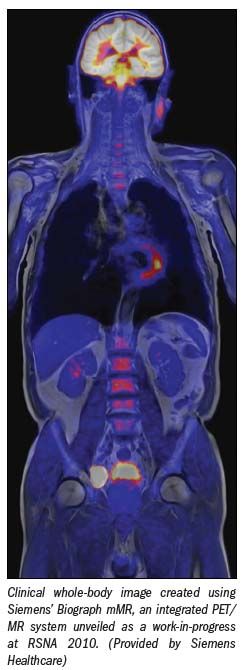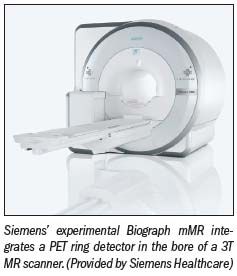PET/MR steps up as first new hybrid modality in a decade
PET/MR is the logical next step in hybridization, the step that follows PET/CT, one that vendors finally took at this year's RSNA meeting. It has come a decade after PET/CT was first commercialized and nearly as long since pundits concluded that its arrival was inevitable.
PET/MR is the logical next step in hybridization, the step that follows PET/CT, one that vendors finally took at this year's RSNA meeting. It has come a decade after PET/CT was first commercialized and nearly as long since pundits concluded that its arrival was inevitable.
At RSNA 2010, GE connected the dots with fusion software and a patient transport system. Philips placed MR and PET technologies in line. And Siemens put them all together.
Hands down, Siemens has the blockbuster product-to-be. It has been a long time coming. The company has been dabbling in PET/MR for years. A mockup of a dedicated brain PET/MR scanner, comprising a PET ring detector inside the bore of a 3T scanner, appeared at the RSNA meeting four years ago. The prototype was used by researchers at the University of Tübingen in Germany and the University of Tennessee in Memphis to produce images of a human brain. It led ultimately to Siemens' development and unveiling at this year's meeting of a full-body PET/MR scanner.

In early November, as this article went to press, the whole-body system, which Siemens emphasizes is a work-in-progress pending FDA clearance, was scheduled to begin investigational operation by late November at the University Hospital Klinikum rechts der Isar of the Munich Technical University in Germany.
Unlike the prototype, this system, prominently featured this year in Siemens' RSNA booth, is in near–production-ready form, according to Walter Märzendorfer, chief executive officer of Siemens MR. The company plans to commercialize its PET/MR, dubbed the Biograph mMR, under a CE label in the European Union in the second half of 2011. Its U.S. launch awaits successful FDA review, which Siemens is currently pursuing.
“This is the world's first fully integrated whole-body molecular MR system,” Märzendorfer said, “meaning that a solid-state PET camera is integrated into the isocenter of a 3T MR scanner, allowing simultaneous acquisition of MR and PET data.”
PET and MR data are acquired simultaneously using components evolved from Siemens' wide-bore Verio 3T MR scanner integrated with a ring detector composed of LSO (lutetium oxyorthosilicate) and high-performance, solid-state Avalanche photodiodes. The MR scanner runs standard protocols as the PET camera collects data in the background, according to Märzendorfer. The solid-state detectors stand in for the photomultiplier tubes typically used in PET/CT. It has to be that way, he said, to truly integrate MR and PET. Conventional PET detectors' reliance on vacuum tubes would render them useless in a magnetic field.

The Avalanche photodiodes are of the same ilk as the ones used in the early models of Siemens' prototypical brain PET/MR scanner. Early tests proved that synchronous acquisition of both MR and CT data could be accomplished with no loss in image quality, Märzendorfer said.
The 70-cm bore of the 3T system cleared enough room to position the PET detector and its photodiodes compactly enough that scanning could expand from just the brain to the whole body. Integrating the PET detector ring and photodiodes into the bore of the MR scanner reduced the aperture to 60 cm, the industry standard diameter for an MR bore, according to Britta Fuenfstueck, Siemens vice president of business development for healthcare.
“This is such a compact and MR-compatible design that it is possible to build (the Biograph mMR) without compromising the patient aperture,” she said.
Unlike some advanced technologies developed for flagship products, the Avalanche photodiodes are not likely to migrate into other PET products in the Siemens portfolio. They were developed, Fuenfstueck said, for the very demanding environment that surrounds PET/MR and will, therefore, be used only on the Biograph mMR in the foreseeable future.
“They are significantly more expensive than other detectors and we want to keep the cost of PET/CTs at the level they are today,” she said.
Märzendorfer deflected questions about the clinical potential of the Biograph mMR, noting that this has yet to be determined by clinical researchers. But enough preliminary work has been done using the prototype brain scanner to suggest that PET/MR has significant potential in the brain; for example, in identifying early-stage Alzheimer's disease and assessing stroke. PET/MR may also have roles in oncologic and pediatric applications. The Biograph mMR would be well suited to soft tissue applications that MR does especially well. Children may also benefit from scans performed on the system, because Siemens' work-in-progress PET/MR minimizes radiation dose to the patient.
ONCOLOGIC APPLICATIONS
Philips executives are similarly cautious not to cross the line between technical and clinical specifications. But experience with MR and PET separately and preliminary tests with the hybridization of these technologies demonstrate their combined potential for characterizing certain cancers.

Researchers using Philips' experimental Ingenuity TF PET/MR have produced striking images of the breast and prostate. Philips' 3T MR component provides the high resolution needed to assess soft tissue, and PET provides the functional information, said Philips executive Dominic Smith, referring to images of the breast and prostate obtained by investigators using the Ingenuity PET/MR under institutional review board approval.
“There is no mistaking where the lesion is,” Smith said.
Other studies are under way using the experimental system to characterize plaques found in blood vessels and to look at brain anatomy and function.
When it comes to acquiring the data for these images, Philips has taken a different tack than Siemens. As they did with PET/CT, company engineers have lined up two scanners, one for MR and the other for PET, and connected them with a single patient table. Data are acquired sequentially. Patients fitted with MR coils are first examined on the 3T scanner, then conveyed on the patient table into the ring detector of the in-line PET scanner.
The design of this in-line system, which is not yet commercially available in the U.S. and will remain a work-in-progress pending FDA review, will offer an advantage to prospective customers, according to Smith. Its two major components, the MR and PET scanners, will be able to operate as stand-alone systems.
“Let's say it goes into an institution (after passing regulatory review) that wants to use it for three days of research,” he said. “The other two days (of the work week) it can be used to handle overflow patients with the 3T and PET systems operating individually.”
The system shown on the RSNA exhibit floor in Philips' booth is the same system in use at three clinical research sites around the globe, one in Europe and the other two in the U.S. These sites are generating clinical information, according to Smith, that will be used to support the company's FDA application regarding the Ingenuity PET/MR. Selected images from these studies were on display at the Philips booth.
Like Siemens, Philips foreshadowed its 2010 unveiling. Research discussed 18 months earlier, at SNM 2009, described a PET/MR system that uses MR instead of CT to perform attenuation correction. All PET systems need to account for attenuation, the divergence or scattering of photons that can distort the image. MR-based attenuation is preferable, as it spares the patient radiation dose from using a CT onboard the PET scanner.
INTEGRAL APPROACH
GE rounds out the major vendors with PET/MR at RSNA 2010. Its approach is more integral than integrated. Rather than combining PET and MR into a single scanner, the company focuses on the elements that combine these two modalities: a patient table and image fusion software.

Images being shown in the GE booth at McCormick Place were constructed from data acquired during MR and PET exams performed sequentially. A patient table docks with the company's FDA-cleared MR and PET/CT scanners; software fuses the data sets from the two exams.
“What we want to show is that when you put these four things together (the two scanners, the table, and software), you can combine the power of MR and the power of molecular imaging,” said Vivek Bhatt, GE's general manager of PET.
A big advantage, he said, is that the components of this offering can be used flexibly within a department, applying the PET/CT and MR individually for clinical cases and using the two together to conduct research. All components of the PET/MR offering are commercially available, as they have been 510K-cleared by the FDA. They represent, Bhatt said, a financially responsible solution for GE's customers.
“PET/MR is still in the research realm,” he said. “So the question is, are you going to take very expensive equipment and just have it sitting around for use once in a while when it is needed for research? Or would you rather have fully 510K-cleared systems that you can use to do reimbursable studies and generate cash flow for your site?”
Reliance on PET/CT exposes the patient to radiation not needed when using MR-based attenuation correction. But the GE approach minimizes patient radiation exposure by using advanced dose-saving technologies, including the company's high-end ASIR (adaptive statistical iterative reconstruction) algorithm, he said.
Bhatt noted that the patient transport system and fusion software were the focus of the company's PET/MR presentation in its RSNA booth.
“We wanted to talk to customers about how easy it is to get the high-quality images they are looking for to enable their research and clinical needs,” he said. “I know the world has been looking at PET/MR as a new capability, but what we are saying is that this capability exists today.”
Study: Monitoring of Prostate MRI Exams Could Lead to 75 Percent Reduction of Gadolinium Contrast
March 17th 2025While DCE MRI was deemed helpful in over 67 percent of cases in which it was used, researchers found that monitored prostate MRI exams, which facilitated a 75 percent reduction of DCE MRI sequences, had comparable sensitivity for prostate cancer as non-monitored exams.